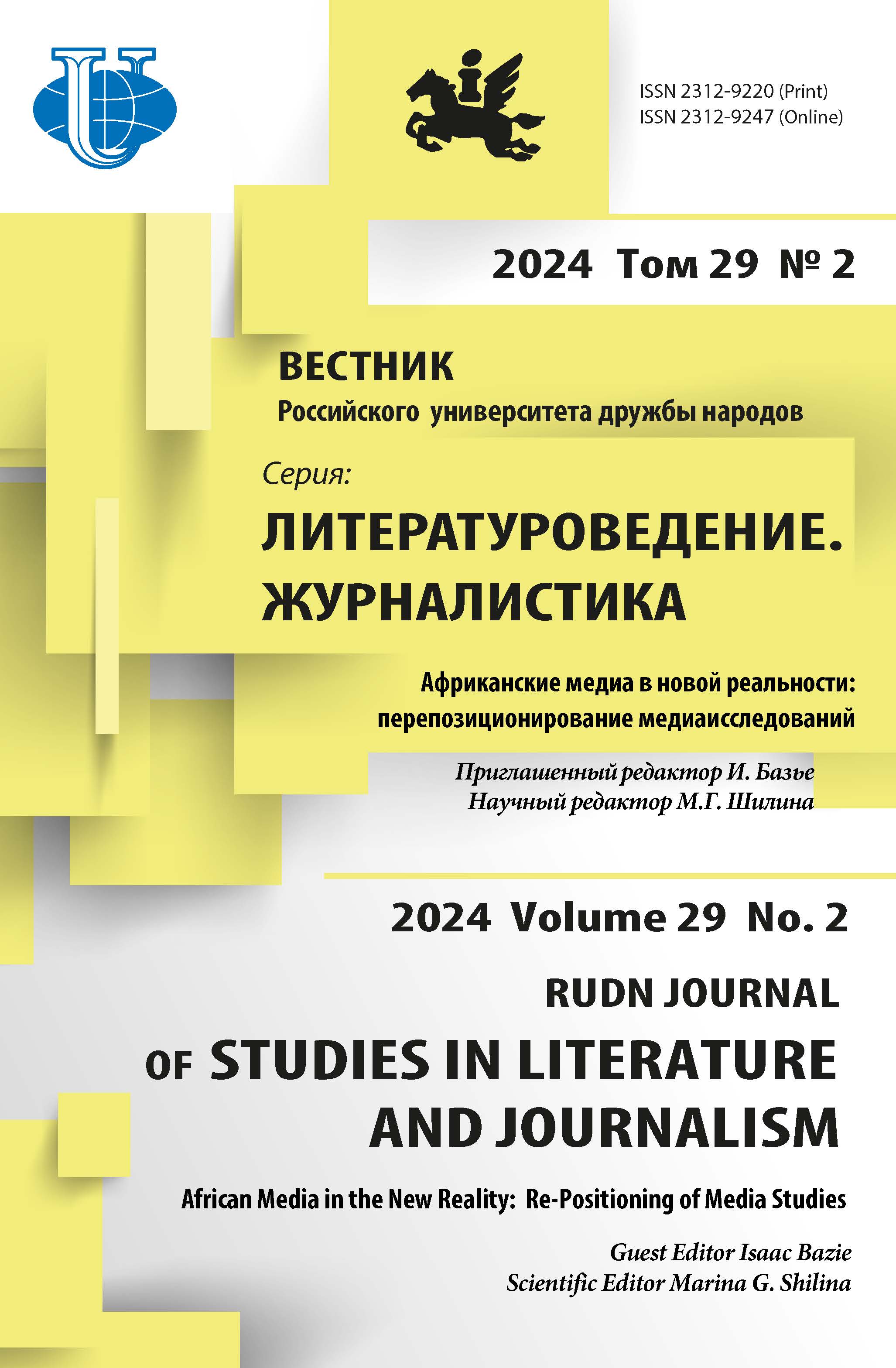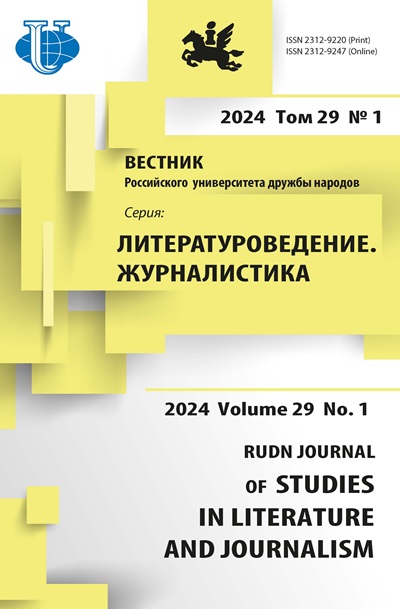TV channels in a period of turbulence: content strategies in social media
- Authors: Kruglova L.A.1, Shchepilova G.G.1
-
Affiliations:
- Lomonosov Moscow State University
- Issue: Vol 29, No 1 (2024)
- Pages: 135-151
- Section: JOURNALISM
- URL: https://journals.rudn.ru/literary-criticism/article/view/40033
- DOI: https://doi.org/10.22363/2312-9220-2024-29-1-135-151
- EDN: https://elibrary.ru/HBALMC
Cite item
Full Text
Abstract
The results of the examination of six Russian TV channels (Channel One, Rossiya 1, NTV, STS, TNT, Friday!) are presented, the peculiarities of their work with social media VKontakte and Odnoklassniki are revealed. An attempt was made to identify the changed digital content strategies of TV channels in turbulent conditions. The effectiveness of TV accounts in social media during four weeks of 2022 and 2023 has been studied. The following parameters were analysed: number of posts, user comments, views and likes. Based on audience and channel activity, the Engagement Rate of users in the published content was determined. The most popular publications among the audience were identified, their formats and thematic focus were reviewed. The return of interest to the Odnoklassniki resource was noted. The tendency of the past years when TV channels duplicated content in their accounts of various social networks was also recorded. During the period of changes in the media landscape and social turbulence, the audience demand for news agenda, on the one hand, and entertainment, or rather “distracting” content, on the other hand, was noted.
About the authors
Lyudmila A. Kruglova
Lomonosov Moscow State University
Author for correspondence.
Email: abiljo@mail.ru
ORCID iD: 0000-0001-5022-4772
Candidate of Philology, Associate Professor, Associate Professor at the Department of Television and Radio Broadcasting, Faculty of Journalism
9 Mokhovaya St, bldg 1, Moscow, 125009, Russian FederationGalina G. Shchepilova
Lomonosov Moscow State University
Email: shgg@yandex.ru
ORCID iD: 0000-0002-0339-1188
Doctor of Philology, Professor, Head of the Department of Tele- vision and Radio Broadcasting, Faculty of Journalism
9 Mokhovaya St, bldg 1, Moscow, 125009, Russian FederationReferences
- Chobanyan, K. (2020). Up for a challenge? Digital practices of 24-hour news channels. World of Media. Journal of Russian Media and Journalism Studies, (3), 35–56. https://doi.org/10.30547/worldofmedia.3.2020.2
- Dolgova, Y.I., & Sheptuha, K.V. (2023) Infotainment in the evening news of Russian TV channels. The Art and Science of Television, 19(4), 119–147. (In Russ.) https://doi.org/10.30628/1994-9529-2023-19.4-119-147
- Dugin, E.Ya. (2023). Journalism in the conditions of a communicative turn. Journalist. Social Communications, 50(2), 10–20. (In Russ.)
- Faikova, S.D. (2022). Social networks as a tool for forming youth loyalty to Russian TV channels. Znak: Problemnoe Pole Mediaobrazovaniya, 45(3), 81–94. (In Russ.) https://doi.org/10.47475/2070-0695-2022-10309
- Hoeck, L., & Spann, M. (2019). The effects of first and second screen marketing on TV viewing activity. Journal of Media Economics, 32(3–4), 82–98. https://doi.org/10.1080/08997764.2021.1890751
- Hradziushka, A.A. (2023). Platform journalism: Specifics and trends. Journal of the Bela- rusian State University. Journalism, (1), 4–9. (In Russ.)
- Lewis, S., & Molyneux, L. (2018). A decade of research on social media and journalism: Assumptions, blind spots, and a way forward. Media and Communication, 6(4), 11–23. https://doi.org/10.17645/mac.v6i4.1562
- Nelson, J.L., & Lei, R.F. (2017). The effect of digital platforms on news audience behavior. Digital Journalism, 6(3), 619–633. https://doi.org/10.1080/21670811.2017.1394202
- Polyakov, M.L. (2023). Interaction of digital platforms and states: Events and phenomena 2019–2022. Vestnik of Voronezh State University. Series: Philology. Journalis, (1), 116–120. (In Russ.)
- Proskurnova, E.L., Zhu, W., & Volkova, I.I. (2023). Experience of posting news in the format of short videos by Chinese TV channels on Douyin. The Art and Science of Television, 19(4), 233–269. (In Russ.) https://doi.org/10.30628/1994-9529-2023-19.4-233-269
- Rogers, E. (2003). Diffusion of innovations. New York: Free Press.
- Rozov, N.S. (2019). Epochs of turbulence and ways to overcome them. Politeia, 92(1), 81–96. (In Russ.) https://doi.org/81–96.10.30570/2078-5089-2019-92-1-81-96
- Shawky, S., Kubacki, K., Dietrich, T., & Weaven, S. (2019). Using social media to create engagement: A social marketing review. Journal of Social Marketing, 9(2), 204–224. https://doi.org/10.1108/JSOCM-05-2018-0046
- Shchepilova, G.G., & Kruglova, L.A. (2018). TV channels and social networks: The specifics of interaction. Vestnik Moskovskogo Universiteta. Seriya 10. Zhurnalistika, (3), 3–16. (In Russ.) https://doi.org/10.30547/vestnik.journ.3.2018.316
- Sokolov, A.V. (2023). The influence of digital platforms on the communication strategies of traditional media. Journalist. Social Communications, (1), 108–118. (In Russ.)
- Srivastava, J., Saks, J., Weed, A.J., & Atkins, A. (2018). Engaging audiences on social media: Identifying relationships between message factors and user engagement on the American Cancer Society’s Facebook[76] page. Telematics and Informatics, 35(7), 1832–1844. https://doi.org/10.1016/j.tele.2018.05.011
- Stefanone, M.A., Lackaff, D., & Rosen, D. (2010). The relationship between traditional mass media and “social media”: Reality television as a model for social network site behavior. Journal of Broadcasting & Electronic Media, 54(3), 508−525. https://doi.org/10.1080/08838151.2010.498851
- Subhayan, M., Sílvia, M.-V., & Sandra, G.-B. (2018). Networks of audience overlap in the consumption of digital news. Journal of Communication, 68(1), 26–50. https://doi.org/10.1093/joc/jqx007
- Syrdal, H.A., & Briggs, E. (2018). Engagement with social media content: A qualitative exploration. Journal of Marketing Theory and Practice, 26(1–2), 4–22. https://doi.org/10.1080/10696679.2017.1389
- Urazova, S.L. (2022). Metamorphosis of the media system in the perspective of digital accele- ration. Social Sciences and the Humanities, 22(1), 100–107. (In Russ.)
- Urazova, S.L. (Ed.). (2021). Media ecosystem: Digital modifications. Chelyabinsk: SUSU Publ. (In Russ.)
- Volkova, I.I. (2019). TV Channels on YouTube: Reasons for ineffectiveness. Journalism in 2018: Creativity, Profession, Industry: Materials of the International Scientific and Practical Conference (pp. 468‒469). Moscow: MSU Publ. (In Russ.)
- Volkova, I.I., Proskurnova, E.L., & Chan, T.Z. (2021) On the prospects of news television: Materials from in-depth interviews. Nauchnyi Dialog, (3), 157–170. (In Russ.) https://doi.org/10.24224/2227–1295-2021-3-157-170
- Volkova, М.М., & Glazkova, S.А. (2021). Characteristics of communication strategies for promoting regional Russian TV channels in social media. Petersburg Economic Journal, (3), 14–21. (In Russ.) https://doi.org/10.24412/2307-5368-2021-3-14-21
















